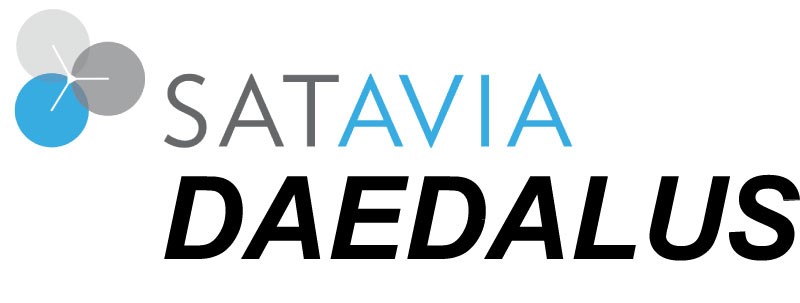
Objectives of the service
Adverse meteorological (MET) conditions (e.g., turbulence, convection and wind shear; icing conditions including high altitude ice clouds; volcanic ash and dust clouds, lightning) create costs for operators (e.g., extra fuel burn; flight delays, diversions or cancellations) and can potentially compromise the safety of flight operations. Satavia (UK) is currently leading DAEDALUS, a feasibility study to assess the technical and commercial viability of novel aviation MET service elements based around European space assets. The Feasibility Study runs between Jan-Oct 2015 and on successful completion should lead into a larger Demonstration Project lasting approximately 2 years.
The DAEDALUS service offered by Satavia aims to assist airlines, air navigation service providers (ANSP), and airframe and aeroengine manufacturers to increase operational safety and efficiency, and increase situational awareness of stakeholders on aircraft and the ground. Key objectives include in-flight detection and forecasting of a range of aviation hazards, and analytics to support flight operations.
Users and their needs
Key user groups include: airlines, ANSP, and aeroengine and airframe manufacturers. The project is coordinated by Satavia (UK), and project partners include Avinor ANS (NO), OddArtTM (NO), Satellite Applications Catapult (UK), SINTEF ICT (NO) and University of Oslo (NO).
The DAEDALUS consortium is supported by key industry stakeholders including British Airways (UK), Rolls-Royce (UK), Inmarsat (UK), Met Office (UK), Lufthansa Systems (GE), Droplet Measurement Technologies (DMT; US), NCAR Atmospheric Research Lab (US) and Telespazio VEGA (GE).
User needs include:
- Improved observational and forecast information on the prevalence of MET threats
- Product compatibility with existing aircraft and surface systems and interfaces
- Seamless end-to-end solution linking aircraft, space and surface segments.
DAEDALUS has a focus on icing, turbulence and dust hazards, and offers services to reinforce flight safety and operational efficiency. System/product specification is focussed on the synchronisation of situational awareness products shared between stakeholders at the surface and on aircraft. Technical development during the Feasibility Study includes:
- ‘Big data’ framework for data assimilation and management
- Adaptive data communications framework including innovative methods to optimise aircraft-surface data communications
- On-board cloud particle measurement system for commercial aircraft
- Flight trajectory analytics
- User interface applications.
The targeted users are based in the UK, Norway, USA and Europe.
Service/ system concept
Satavia offers to aircraft engine manufacturers and aircraft operators digital environmental intelligence on atmospheric contaminants to improve the safety, performance and operating costs of aviation. Environmental factors in the atmosphere, like dust, sulphur, ice, and volcanic ash, accelerate wear of aircraft components and unscheduled maintenance costs the industry billions each year.
Satavia’s cloud-based digital intelligence platform uses big data and advanced analytics to track the exposure of any aircraft, anywhere in the world, to contaminants during flight. Satavia offers data-by-the-hour services to enable airlines and OEM to minimise disruption, proactively plan maintenance, extend asset service life and maximise asset value. The initial focus is on services aimed at OEM to reduce costs by £100Ms/year/OEM customer. In parallel, additional markets will be explored, which may include aircraft operators (flight planning and navigation) and insurance (risk analytics).

Space Added Value
Daedalus uses the following space assets to achieve near real-time delivery of aviation weather products to the key actors in aviation operations:
- Aeronautical satellite telecommunications to provide connectivity between the aircraft and ground
- Earth observation data to create regional-scale near real-time aviation weather observational products.
- Global Navigation Satellite Services (GNSS) to associate precise time and location information with MET exposure analytics.
Current Status
Offshore helicopter issues were not considered in the original Daedalus ARTES IAP Feasibility Study project scope, which had a focus on commercial fixed-wing aviation. However, there was an opportunity late in 2015 to open discussions with helicopter operators, as it became apparent that there were issues related to payload restrictions imposed during icing conditions. There was strong interest from the major stakeholders, including potential customers, in the Norwegian-UK offshore helicopter industry. A contract extension was requested to analyse the business opportunity to deliver a commercial service for helicopters operated in icing regions. Following completion of the business case assessment, Satavia is planning to re-focus on commercial fixed wing aviation. In the future, an icing service to support offshore helicopter flight operations could be an extension of a service focused on commercial aircraft engine health and maintenance. Satavia is planning to move to Demonstration Project phase in 2018.
Prime Contractor(s)
Subcontractor(s)







